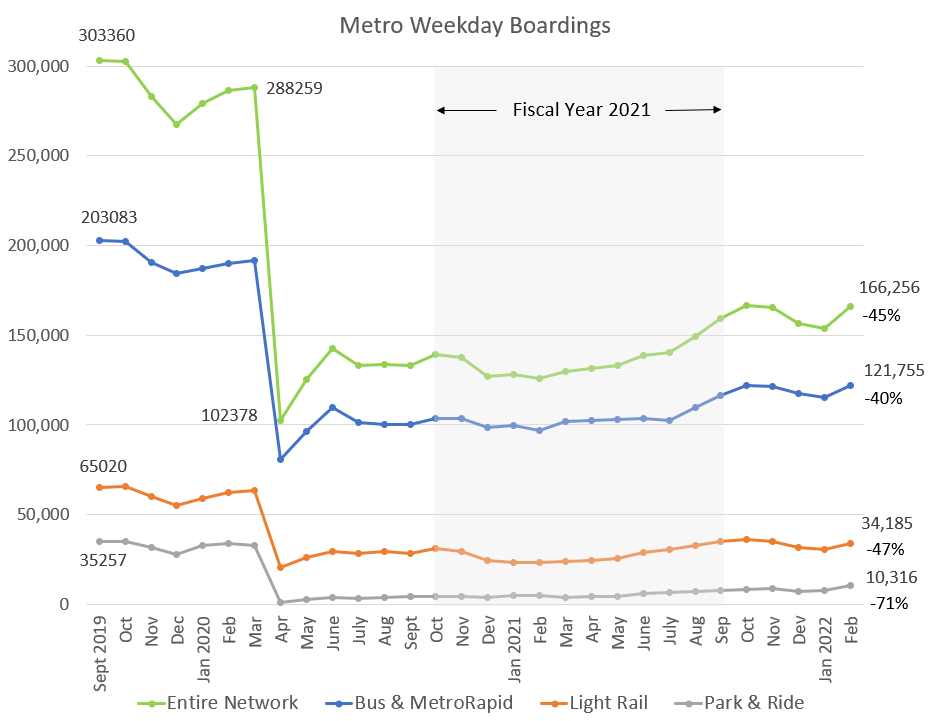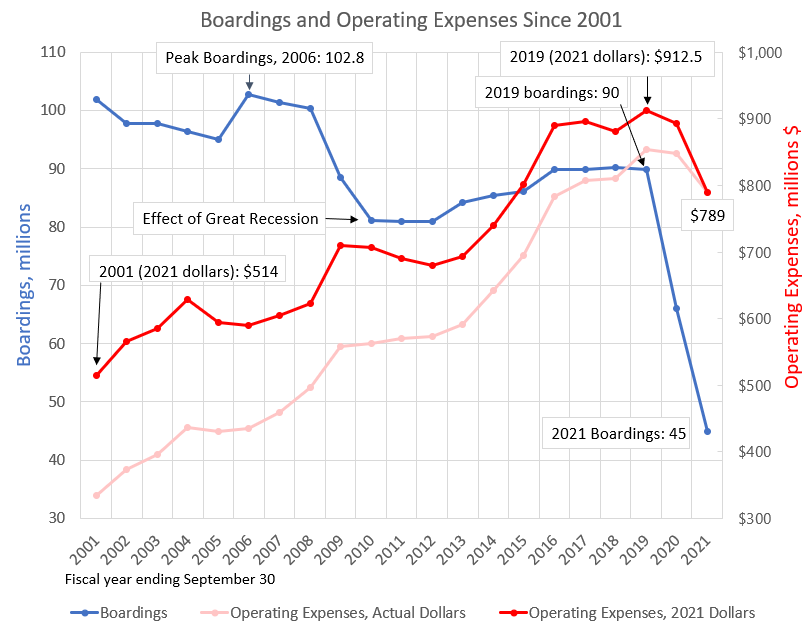With Low Ridership, Should Metro’s Excess Cash Pile Go To Flood Control?
Today we have an excellent analytical guest post with some fantastic charts from Oscar Slotboom. (highlights mine)
Metro’s 2021 annual report, for the fiscal year ending September 30, recently became available.
Fiscal year 2021 is the first annual report entirely affected by Covid (see chart 1). As expected, metrics for ridership and cost per trip became much worse. However, more concerning are Metro’s long-term trends prior to Covid, as the plots below will show.
In spite of ridership being cut in half due to Covid, Metro’s financial position became stronger than ever due to a huge influx of federal grants, a total of $714 million in Covid relief in 2020 and 2021.

Chart 1: Fiscal year 2021 shown on the ridership trends. (Source: Metro ridership reports
Data source for the charts is Metro’s annual reports. Inflation adjustment uses the official CPI calculator.

Chart 2: Boardings and operating expense since 2001
The first impression from this chart is that both trends are going in the wrong direction! Prior to Covid-19, inflation-adjusted operating expense was up 77.5%, from $514.2 million in 2001 to $912.5 million in 2019, while ridership was down 11.7%. Ridership peaked in 2006 at 102.8 million boardings, and by 2012 had declined 21.2% due to the Great Recession. By 2016 ridership had recovered to 90 million boardings, down 12.5% from the peak, where it held steady until Covid-19. 2021 ridership of 45 million was down exactly 50% from 2019.

Chart 3: Cost, subsidy and average fare per boarding since 2001.
Of course, the cost per boarding goes up with rising operating expense and declining and/or flat ridership. Cost per boarding is calculated by (operating expense)/boardings, and subsidy per trip is (operating loss)/boardings. Prior to Covid-19, the cost per boarding in 2021 dollars was up 101%, from $5.05 in 2001 to $10.14 in 2019. The inflation-adjusted subsidy per boarding in the pre-Covid period rose 119%, from $4.27 in 2001 to $9.25 in 2019. In 2021 the cost per boarding was $17.57 and the subsidy per boarding was $16.98. Stated another way: in 2021 taxpayers handed over $16.98 every time someone stepped on a Metro bus or train.

Chart 4: Total fare revenue and average fare per boarding since 2001.
Inflation-adjusted fare revenue was generally flat in the 11 years prior to Covid, varying between $79 and $88 million, with the average fare per boarding between $0.89 and $1.03. The base Metro fare is $1.25 but many riders qualify for discounts. In 2021, fare revenue dropped to $26.7 million and the average fare per boarding was $0.59.
Read the rest of this piece at Houston Strategies Blogspot.
Tory Gattis is a Founding Senior Fellow with the Urban Reform Institute (formerly Center for Opportunity Urbanism) and co-authored the original study with noted urbanist Joel Kotkin and others, creating a city philosophy around upward social mobility for all citizens as an alternative to the popular smart growth, new urbanism, and creative class movements. He is also an editor of the Houston Strategies blog.







 Dhanix, used under CC 3.0 License
Dhanix, used under CC 3.0 License Wendell Cox, used with permission
Wendell Cox, used with permission